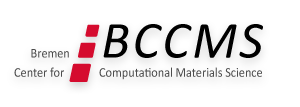Further Information
Experiment
The encoding of information onto individual quantum states and use for communication, memory, and computation is a driving motivation for interdisciplinary research. The synthesis of materials and characterization of the material structure, property, and performance provide opportunities to fundamentally shape the realization of quantum information devices. Linked improvements in materials fabrication, characterization, and simulation are needed to improve quantum computing materials and create new materials that may have a revolutionary impact on quantum information device design.
It is now becoming apparent that solid state color centers and qubits with photon manipulation techniques can be used for ultraprecise quantum metrology in physics, material science, or applied cross disciplinary to chemistry and biology. So far these have been proven by the nitrogen-vacancy (NV) center in diamond. Some examples are magnetometry, imaging of nano-electronic circuits, high performance sensing elements to reach single-molecular sensitivity and resolution, NMR quantum techniques for detecting chemical composition of single molecules or reading signals in neural cells. This research requires cutting-edge developmental efforts in the quantum-device field, material science and quantum sensing. Particularly, the attractive spin properties of the solid state qubits are often deteriorated when placed close to the surface for sensor applications. It is suspected that the surface defect spins and electronic states are responsible for this issue. Defect engineering and precise localization of the target qubit is required for these quantum technology applications. The defect created unintentionally in this procedure may limit the operation of qubits. It is evident that first principles modeling of materials and study of these atomistic processes is of immediate interest in this field.
The color centers in solids may act as single photon sources that can be important building blocks for quantum communication. Recently, plethora of solid state single photon sources have been engineered in various 3D and 2D materials, however, the most of these single photon emitters are unidentified defects. Again, ab initio calculations can guide the experiments toward identification and control of qubit creation and optimization of operation. The detailed study of spin-photon interface is also required from first principles, in order to guide experimental researchers in the field.
Theory
Point defects in solids with appropriate magneto-optical properties are attractive candidates to realize single photon sources and quantum bits. A well-established paramagnetic color center is the negatively charged NV defect in diamond, i.e., NV center. The electron spin of the NV center can be initialized optically, whereas the spin flip is usually realized by employing an appropriate alternating magnetic field. The resultant electron spin state can be readout either optically or electrically induced by photo-ionization, i.e., optically (ODMR) or photo-ionization detected magnetic resonance (PDMR). ODMR and PDMR processes includes electron spin – electron spin interaction, electron-phonon interaction, spin-orbit interaction, excitation energies and optical cross section, excited states and level, ionization energies. The hyperfine interaction between the electron spin and the surrounding nuclear spins in the lattice is also an important effect in various quantum technology applications. In addition, the effect of perturbations such as strain, electric field, magnetic field, temperature acting on the solid state qubit is essential to apply these qubits as nanoscale sensors. This is an extremely complex issue and basically all the known physical interactions should be studied and the corresponding parameters should be calculated, in order to have a full description about the solid state qubit. The deep knowledge on the coupling parameters is essential for ultimate control of the qubit and determining the sensitivity in sensor applications. In sensor applications the qubit should be engineered close to the surface of the host material, thus the formation of the qubit and the effect of the surface on the qubit should be also studied from first principles.
The standard methodology in the investigations of point defects in solids is the plane wave supercell density functional theory (DFT) electronic structure calculations that can accurately predict their ground state and ionization energies in many cases. However, it is a great challenge to calculate the excited states where the correlation between the electrons can be so strong that even many-body perturbation theories are insufficient to describe the electron states. The implementation of the theories of magneto-optical parameters within DFT, also as a function of strain, phonons and temperature, is still in its infancy, and should be further studied and developed. Modeling of surfaces with qubits is another important topic that faces several challenges. The formation of qubits is also subject to atomistic first principles simulations.
The full implementation of these physical processes makes possible to characterize and predict novel solid state qubits in 3D and 2D materials. In 2D materials the a priori correction may be needed instead of the recently developed a posteriori total energy corrections for charged defects acting as qubits. All these challenges and new results on these issues will be the topic of this conference where vivid discussions are envisioned on the route of methodological developments in the field, and strong interaction between the theoreticians and experimental researchers is expected.
